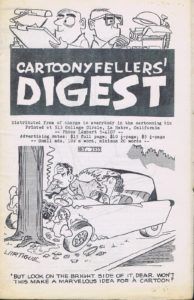Gus Arriola, Bill Watterson, Orrin Evans, and Cartoonyfellers (A Comic Chronicles Edition)
Skip to commentsHow Gus Arriola and Gordo Became Accidental Ambassadors of Mexican Culture
When Arriola started his comic strip, words like ‘burrito’ were unknown in the United States
“Gordo,” August 21, 1966; © UFS, Inc.
Gordo, published between 1941 and 1985, was created, drawn, and written by Arriola; it was distributed by the United Feature Syndicate. The comic strip’s story followed the life of fictional Mexican bean farmer Perfecto Salazar “Gordo” Lopez, who lost the lease on his land and made a living traveling around Mexico as a tour guide. Arriola used Gordo and the tour-guiding theme as a method to introduce Mexico and its people to a wider audience: households in the United States.
Smithsonian Magazine profiles cartoonist Gus Arriola, creator of Gordo.
What techniques did Bill Watterson use to make Calvin and Hobbes a masterpiece?
© Bill Watterson
Depending on who you ask, though, comic strips have been at death’s door since 1996. Why is that date so significant? The 31st of December in 1995 marked the last time that Bill Watterson’s groundbreaking comic strip Calvin and Hobbes ran in newspapers.
If you’re not a fan of Calvin and Hobbes, you might wonder why the strip is so revolutionary and revered. In the video linked [below] from The Comics Cube’s YouTube channel, you can see some of the techniques Watterson employed to create gorgeous comics.
Duy Tano, at The Comics Cube, deconstructs a Calvin and Hobbes Sunday page.
Comic book pioneer and journalist Orrin C. Evans
The creations of Orrin Cromwell Evans.
If you don’t know much about the publication of Black comic books and strips in newspapers then you probably know little about Orrin.
With his partners the sports editor Bill Driscoll and Harry T. Saylor, the former editor of The Record, Orrin was a co-founder of All-Negro Comics, Inc. and he was the president.
Orrin, as described by writer Tom Christopher, “Co-created the features in the comic along with the artists, who included his brother, George J. Evans Jr., two other Philadelphia cartoonists, one of whom was John Terrell, and the other named Cooper, and a Baltimore artist who signed his work Cravat. The cartoonists probably wrote their own scripts, and there was further editorial input by Bill Driscoll.”
The Amsterdam News profiles newspaper reporter and comic book publisher Orrin C. Evans.
All-Negro Comics #1 (and only) can be read at the Digital Comic Museum (click “preview”).
Dick Buchanan Files: CARTOONYFELLERS’ DIGEST, “a 1955 rag for cartoonists by cartoonists”
Here’s another obscure “insider publication” rescued from gag cartoon oblivion. This one is really an early “zine”
It was edited & published by Carl Kohler under the auspices of Lew Card. Cartoonyfellers’ Digest like its predecessor, Inkyfeller’s Gagzette, was sent “free to everyone in the cartooning biz.” At the time, that was about 3000.
From Dick Buchanan and Mike Lynch comes the 32 page CARTOONYFELLERS’ DIGEST May, 1955.



Comments
Comments are closed.